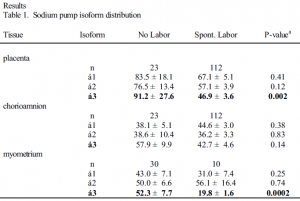David S. Faux and Dr. Steven W. Graves, Chemistry and Biochemistry
The birth of a baby has always been regarded as a miracle. Even today the carefully orchestrated events that result in birth elude the outreaches of scientific research. Among the most important of these events are the contractions of the uterus termed labor. Several factors are known to be important in the initiation and maintenance of labor, including hormones secreted by the placenta and the aminochorionic membranes. The mechanisms or factors that increase secretion and/or production of these activating agents are less well understood.
One mechanism that increases hormone release from secretory tissues is a reduction in sodium pump activity. The sodium pump, or [Na,K]ATPase is a protein made of at least two subunits. The catalytically active component, the á-subunit, has at least three forms. The sodium pump pumps sodium out of the cell while pumping potassium in. Reductions in its activity cause an accumulation of cell sodium, which in turn results in an increase in ionized calcium within the cell. Increased calcium is the most common mediator of hormonal release from many secretory cells. The increase in free calcium also increases vascular smooth muscle contraction.
The possibility of a regulated decrease in sodium pump number as a possible mechanism of increased hormone secretion or increased muscle contraction has never been explored. We hypothesize that labor is mediated by a reduction in the abundance of one or more sodium pump á-isoforms in the placenta and/or aminochorion, which represents a potential mechanism for the increased secretion of participating factors from these tissues during labor. We also predict a decrease in isoform abundance in the uterus of women who have experienced labor compared to those who have not, allowing the increased muscle contractions necessary for birth.
Methods
After approval of the clinical study protocol by the Institutional Review Board, participants were recruited among women delivering at the University of Utah Health Sciences Center. All patients gave informed, signed consent. Samples of placenta and chorioamnion were collected after successful term (>36 weeks gestation) deliveries in women with spontaneous labor. Placenta, chorioamnion, and myometrium were also collected from laboring and non-laboring patients following Cesarean section. Labor was defined as the presence of regular uterine contractions (>3 contractions in a 10 minute period) with advanced cervical dilation (>3 centimeters.)
Tissue samples were frozen upon removal and remained so until homoginized on ice. Protein concentrations of each homogenate were determined by Lowry assay. Equal amounts of protein (50 ìg) were separated on a 7% SDS-polyacrylamide gel electrophoretically. This process uses the charge on proteins to separate them by size in a porous gel. The proteins were transferred to a nitrocellulose membrane and incubated with an antibody specific to either the á1, á2, or á3 sodium pump isoform. The protein was visualized by means of a secondary antibody bound to the first, which produced a chemiluminescent signal after reacting with the appropriate substrate. Membranes were scanned to determine the relative amounts of sodium pump isoform in each tissue. Values were normalized using a common tissue on each gel. Comparisons of the abundance between labor and no labor groups were made using an unpaired Student’s t-test. A P value < 0.05 was considered statistically significant.
a. Values from an unpaired Student’s t-test; Spont. Labor = spontaneous labor.
Discussion
We hypothesized that labor would result in a reduction of one or more of the sodium pump isoforms in the tissues studied, which was true in part. As shown in Table 1, the relative sodium pump abundance was lower for patients in labor in every category except the á1 isoform in chorioamnion and the á2 isoform in myometrium. The á3 isoform was the most interesting. Relative levels of the á3 isoform were significantly less in the placenta and myometrium. These reductions did not appear to represent the duration of labor, and consequently may represent changes that occurred in anticipation of labor. The evidence supports the idea that reductions in sodium pump number may trigger the hormonal secretions by the placenta, and the increased muscle contractions of the uterus which both contribute to the initiation and maintenance of labor.

